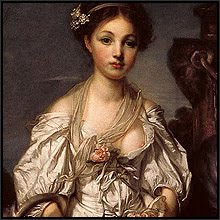
Seven centuries passed. Half a world away in Victorian England, a rather indifferent writer named Edward Fitzgerald decided to compose a translated version of the ancient Persian verses. Something mysterious happened. From the alignment of minds that were the Persian astronomer and the Victorian writer emerged an extraordinary poet who resembled neither, and who - at least in English-speaking minds - eclipsed both. In the West we know those verses as the Rubáiyát of Omar Khayyám, and it is Fitzgerald's translation (which is more of an interpretation) which from its first appearance in 1851 established itself as the definitive and familiar English version.

In Fitzgerald's version, Omar comes across as a cheerfully practical fellow, as fond of his wine as he is of a bit of philosophy, full of good humor in the face of an unforgiving and unrelenting fate. Perhaps inevitably, Fitzgerald's Omar Khayyám attracted the production of several lavishly illustrated editions, including one by the American artist *Elihu Vedder. In 1913 a sumptuous version illustrated by the Irish artist René Bull was published. First editions of the Fitzgerald/Bull version are now rare, but in 1973 I came across one (which, I admit, is now worth several hundred times above the modest amount that I originally paid for it) in an antiquarian dealer's in London's Kings Road.

Most of Bull's illustrations burst with decorative color, but when he came to tackle the verses dealing with human death and fate, rather than continuing in the same style, he seems to have racked things up a notch to transcend his decorative approach. Here, his images resonate with an authoritive power, his color palette is limited to muted tones (the first two, above, and below), and his pen drawings (above) become both dramatic and vivid.

Basically, Omar's simple advice as interpreted by Fitzgerald is that a simple acceptance of circumstances is very different from a passive submission to blind fate. So (says Omar) take things as they come, and live in the moment as you find it, without regret. For all moments, once past, will never return. Or, as Fitzgerald has Omar say in perhaps his most famous verse:
The Moving Finger writes; and, having writ,
Moves on: nor all thy Piety nor Wit
Shall lure it back to cancel half a Line,
Nor all thy Tears wash out a Word of it.

Below, in sequence, are the four numbered verses which accompany the first four illustrations in this post. And if any reader would like to obtain a copy of the Fitzgerald/Bull edition, it is currently available as a modestly-priced contemporary reprint.
31
Up from Earth's Centre through the *Seventh Gate
I rose, and on the Throne of Saturn sate,
And many Knots unravel'd by the Road;
But not the Knot of Human Death and Fate.
32
There was a Door to which I found no Key:
There was a Veil past which I could not see:
Some little Talk awhile of ME and THEE
There seemed---and then no more of THEE and ME.
33
Then to the rolling Heav'n itself I cried,
Asking, "What Lamp had Destiny to guide
"Her little Children stumbling in the Dark?"
And---"A blind Understanding!" Heav'n replied.
53
With Earth's first Clay They did the Last Man's knead,
And then of the Last Harvest sow'd the Seed:
Yea, the first Morning of Creation wrote
What the Last Dawn of Reckoning shall read.
Artist: René Bull
Work: Illustrations for The Rubáiyát of Omar Khayyám, 1913
Medium: Watercolor and pen and ink
Location: Whereabouts of the originals are untraced. Most are presumably in private collections.
Sources:
The Rubáiyát of Omar Khayyám, Rendered into English Verse by Edward Fitzgerald, Illustrated in Colour and in Line by René Bull. Hodder and Stoughton, 1913 (first edition)
The Enigma of Edward Fitzgerald, appearing in Other Inquisitions, 1937-1952, by Jorge Luis Borges. Translated by Ruth L.C. Simms. University of Texas Press, 1964
*See my November 2009 post, The Lair of the Sea Serpent, for more of Vedder's work
*In the ancient world, Saturn was regarded as the seventh planet



































No comments:
Post a Comment
You are welcome to share your thoughts..